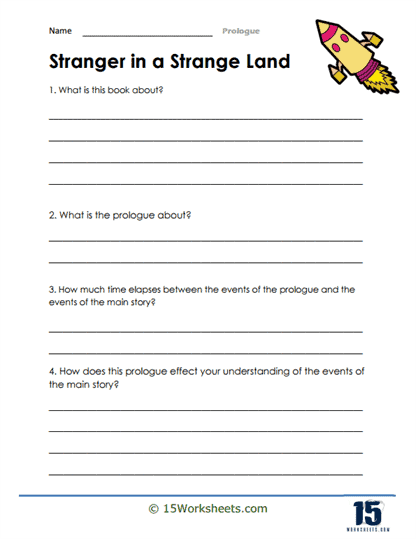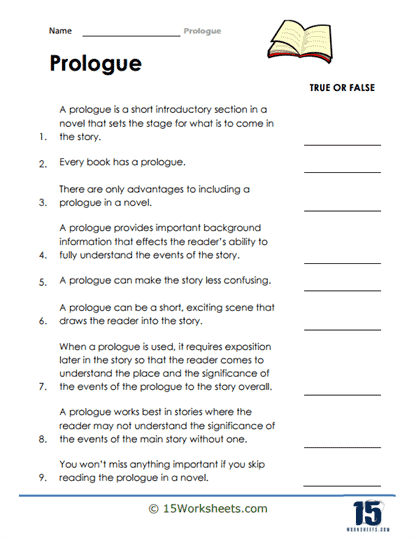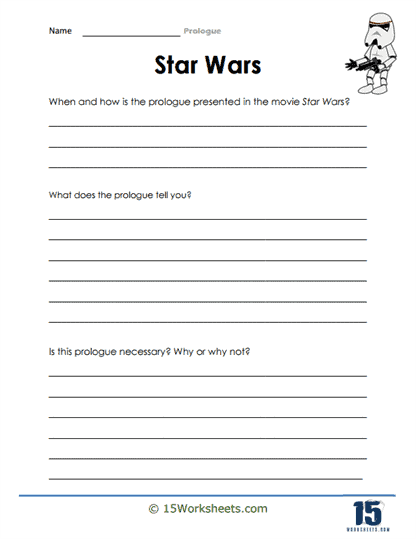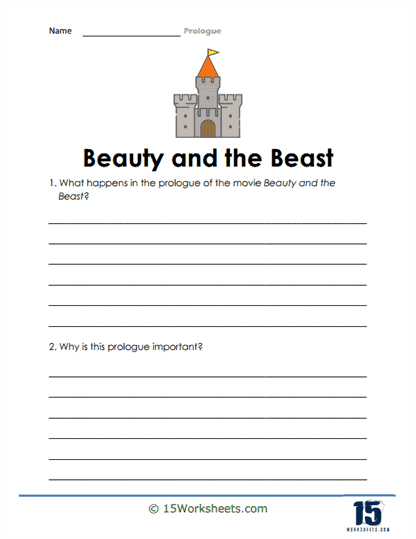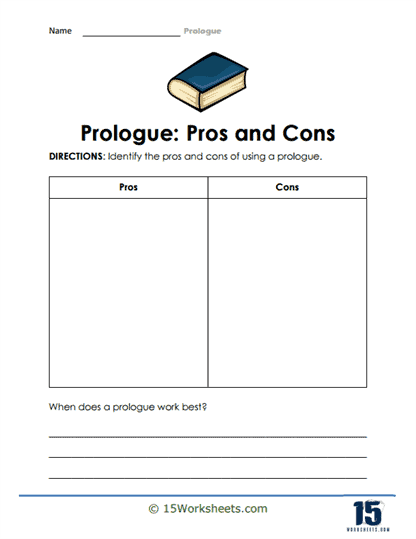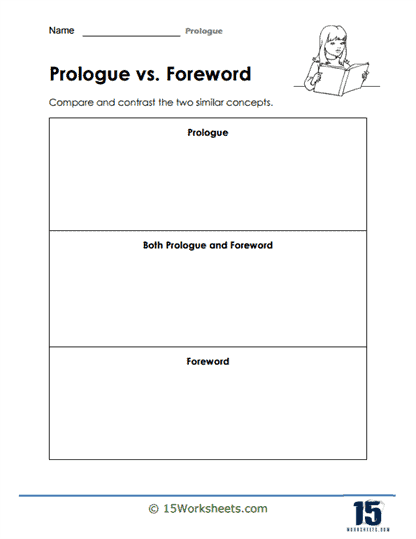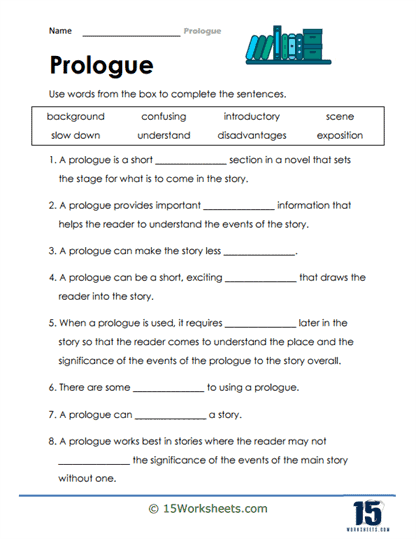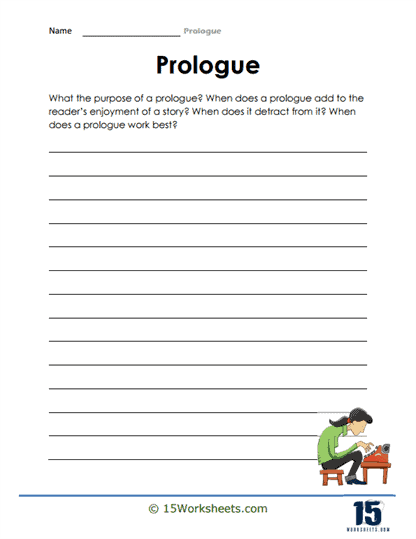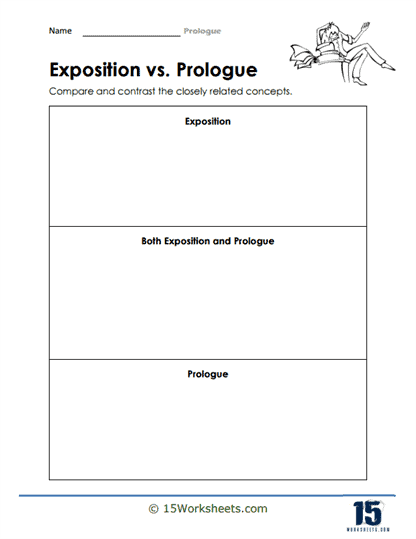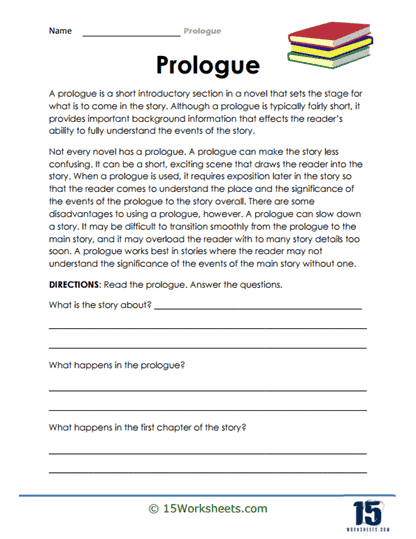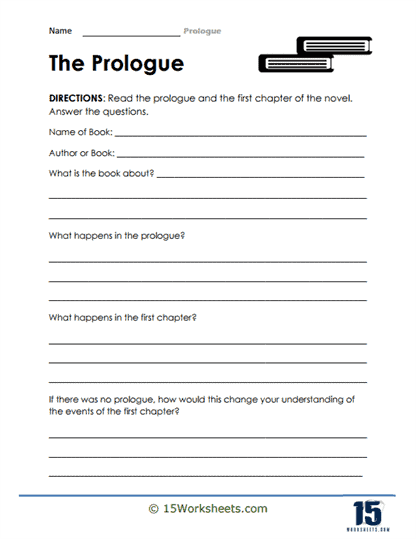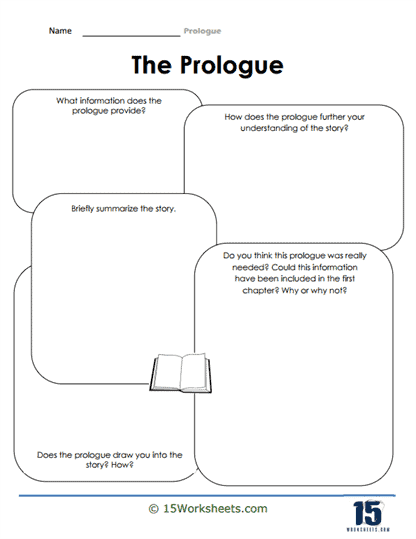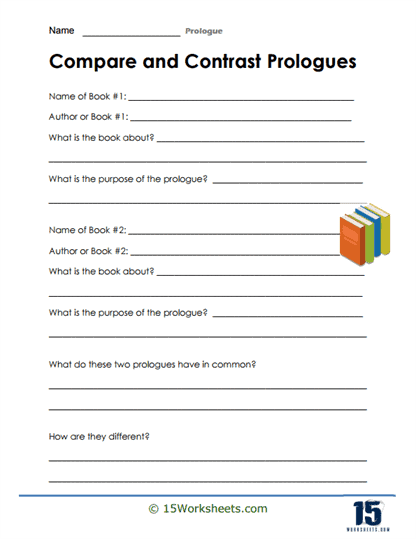Prologue Worksheets
All About These 15 Worksheets
A prologue, an introductory section in a literary work or performance, serves as a gateway to the narrative, setting the stage for what is to come. Understanding prologues is not only important for literary appreciation but also for honing analytical skills, comprehension, and storytelling techniques. This collection of 15 worksheets is designed to introduce students to the world of prologues, helping them grasp the importance of this literary device, recognize its various forms, and develop their own prologue-writing and analytical skills.
What Are Prologue Worksheets?
A prologue, an introductory section in a literary work or performance, serves as a gateway to the narrative, setting the stage for what is to come. Understanding prologues is not only important for literary appreciation but also for honing analytical skills, comprehension, and storytelling techniques. This collection of 15 worksheets is designed to introduce students to the world of prologues, helping them grasp the importance of this literary device, recognize its various forms, and develop their own prologue-writing and analytical skills.
A prologue is a literary tool that serves as an introduction to a story, setting the stage for the main narrative. It might provide important background information, introduce a key character or theme, or present a scenario that explains subsequent events. This literary device can be used to draw readers into the narrative, create intrigue, or establish important context.
These worksheets were developed to help students understand and identify the use of prologues in literature. The types of exercises on such a worksheet could include:
Definition and Examples – These worksheets start by defining what a prologue is and providing a few examples from well-known pieces of literature. This would provide students with a clear understanding of what prologues are and how they function in a story.
Identification Exercises – Students are presented with several different passages, some of which are prologues and some of which aren’t. They would then need to identify which passages are prologues. This would help them to understand the distinctive features of a prologue.
Analysis Questions – These questions involve students reading a prologue and then answering questions about how it sets up the story, what information it provides, and how it might affect a reader’s understanding or expectations of the narrative. This would help them to grasp the function and importance of a prologue within a story.
Creative Writing Prompts – Students are asked to write their own prologues for a given scenario or for a story they create themselves. This would allow them to actively apply what they’ve learned about prologues, reinforcing their understanding of this literary device.
Comparison Exercises – In these exercises, students will compare a prologue to the first chapter of the same book, noting the differences and discussing the unique role that each one plays in the story.
These types of exercises on a prologue worksheet would not only help students understand what prologues are and how they work, but also sharpen their analytical reading skills and stimulate their creative writing abilities.
What is the Literary Device of Prologue?
A prologue is a distinct section that comes before the main narrative in a work of literature. This introductory section serves various purposes such as providing background information, establishing the setting, presenting the conflict, or introducing a key character. The defining feature of a prologue is its separateness from the story’s main action; while it’s related, it remains distinctly set apart, serving as a narrative lens through which the ensuing story is viewed.
Authors use prologues to immediately engage readers, providing a hook that draws them into the narrative. This might be achieved through a dramatic incident, a fascinating character, a puzzling situation, or a tantalizing glimpse of what’s to come. A well-crafted prologue can also enhance the depth and complexity of a story by offering context or a different perspective, fostering a richer reading experience.
Examples of How Prologues Are Used in Literature
Example 1 – “Romeo and Juliet” by William Shakespeare
In “Romeo and Juliet,” the prologue is a fourteen-line sonnet that outlines the entire plot of the play. It reveals that the story involves two “star-crossed lovers” from feuding families, whose tragic deaths ultimately reconcile their families. The prologue sets the stage for the drama to come and frames the narrative as a tragedy.
Shakespeare’s use of a prologue here is to create dramatic irony. Since the audience is aware of the tragic outcome, their anticipation and emotional engagement are heightened. They watch the events unfold, knowing the tragic fate that awaits the characters, which adds a layer of poignancy to the play.
Example 2 – “The Name of the Wind” by Patrick Rothfuss
“The Name of the Wind,” the first book in the Kingkiller Chronicle series, begins with a prologue titled “A Silence of Three Parts.” This prologue paints a vivid picture of the silent inn named ‘The Waystone Inn,’ focusing on the silence itself. It’s a poetic, atmospheric introduction that sets a mood more than it provides direct information.
Rothfuss uses the prologue to intrigue his readers and set the tone for the rest of the novel. The emphasis on silence and stillness creates an atmosphere of suspense and mystery, compelling readers to find out what caused this silence and what will happen next.
Example 3 – “A Tale of Two Cities” by Charles Dickens
In “A Tale of Two Cities,” the prologue, although not labeled as such, is the famous opening line – “It was the best of times, it was the worst of times…” This sentence alone provides a snapshot of the time period in which the novel is set – the French Revolution. It tells the reader that the story will explore a time of intense contradiction, of great hope and great despair.
Through this prologue, Dickens immediately captures his readers’ attention with a paradoxical statement about the historical era that the novel will explore. It creates a sense of curiosity about these contrasts and sets the stage for a narrative that will delve into these extreme circumstances.
Benefits Of Prologue Worksheets For Students
Exploring the world of prologues through this collection of 15 enlightening worksheets offers students an opportunity to develop essential skills in literary appreciation, literary analysis, comprehension, creative writing, and narrative engagement. Prologues are the literary “curtain raisers” that captivate readers and prepare them for the journey ahead.
By engaging with these exercises and activities, students not only enhance their academic abilities but also gain valuable tools for understanding and creating compelling narratives. The benefits of studying prologues extend far beyond the classroom, empowering students to be more discerning readers, skilled writers, and active participants in the world of storytelling.



